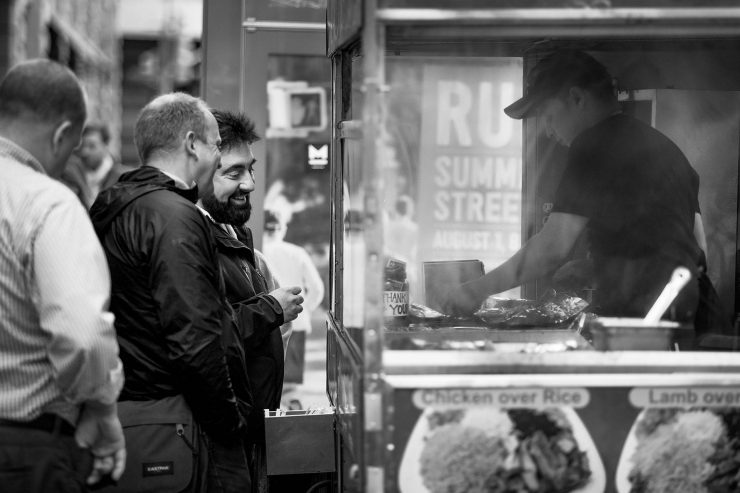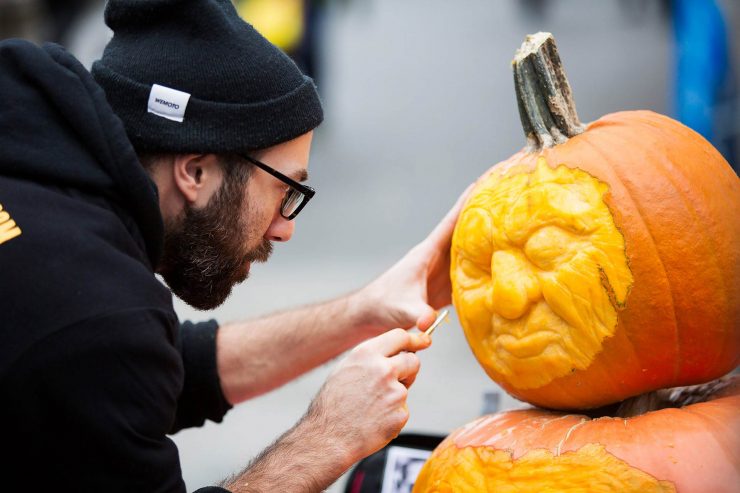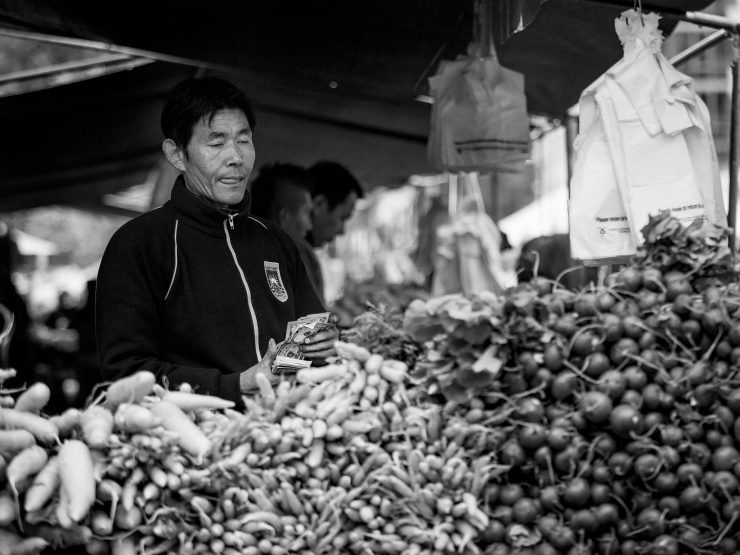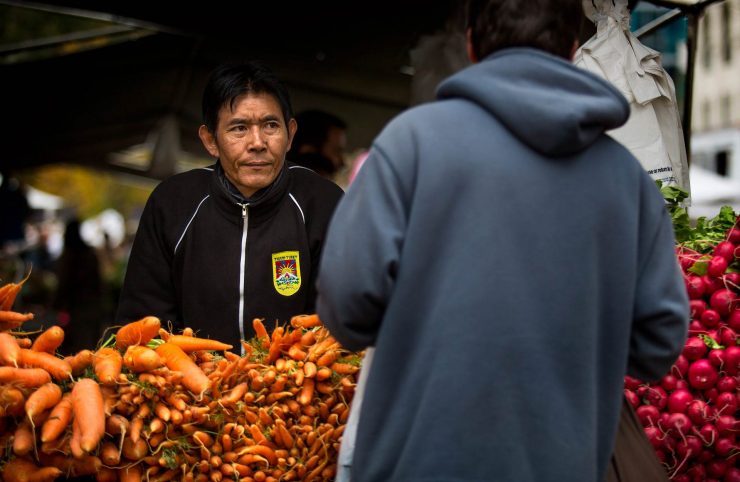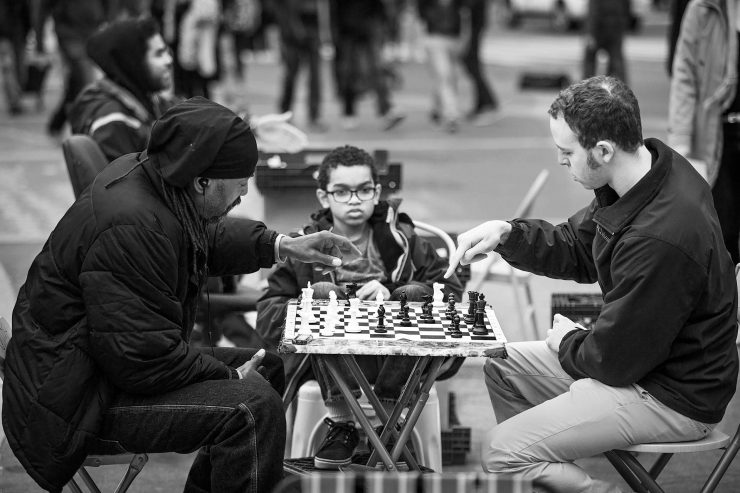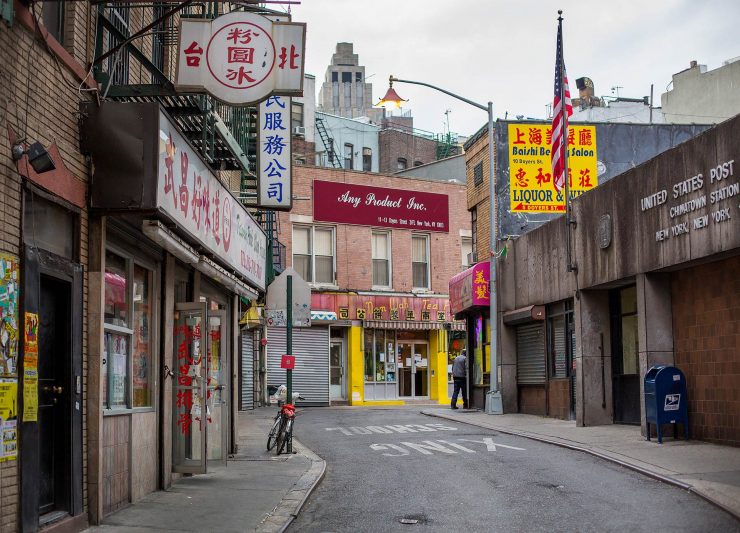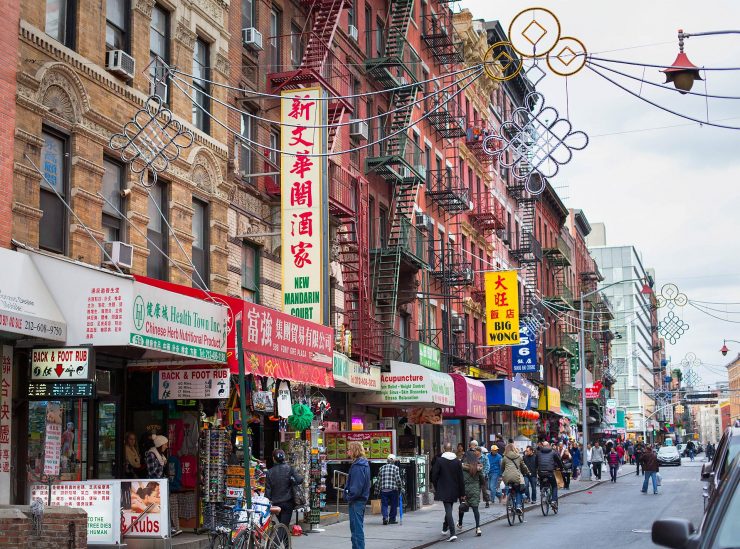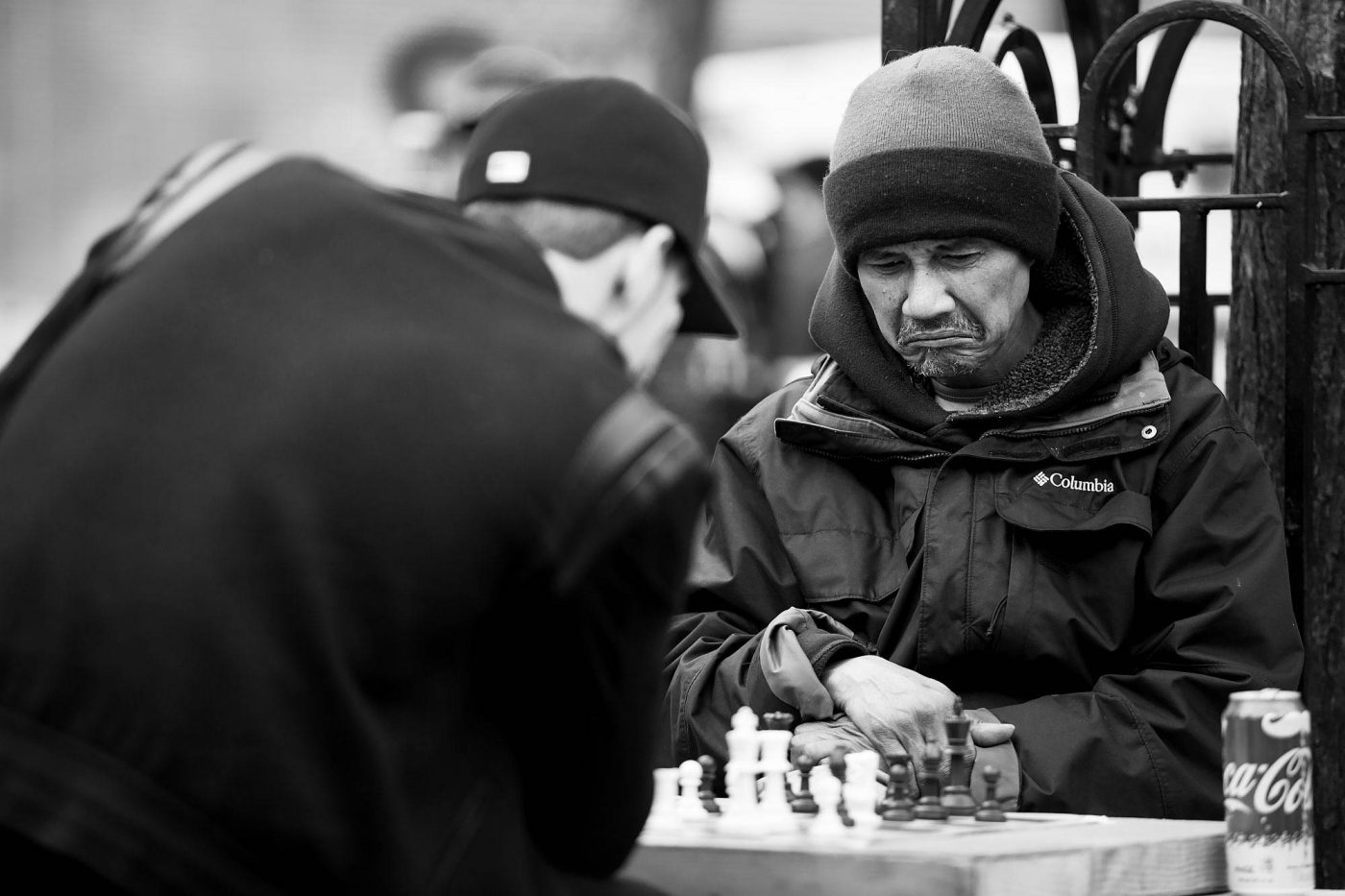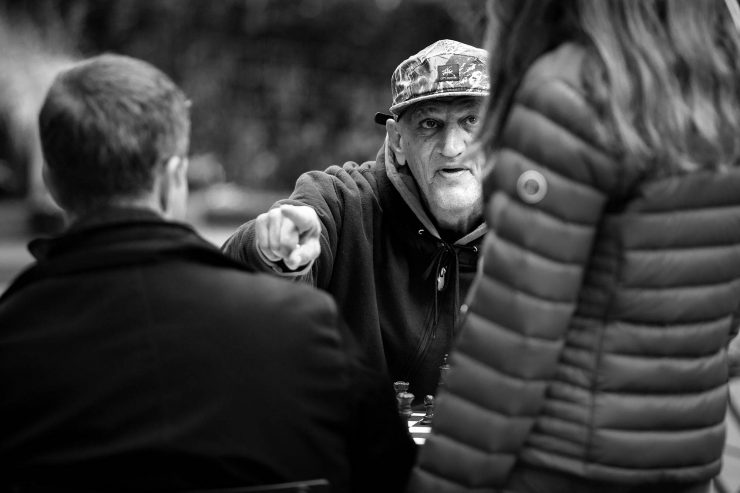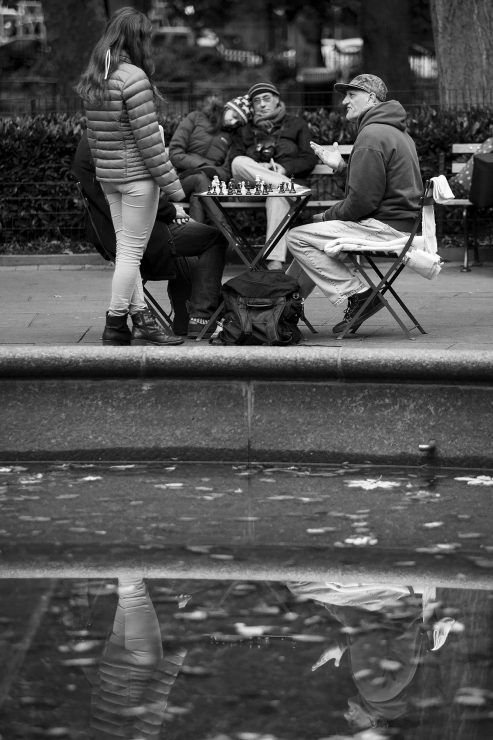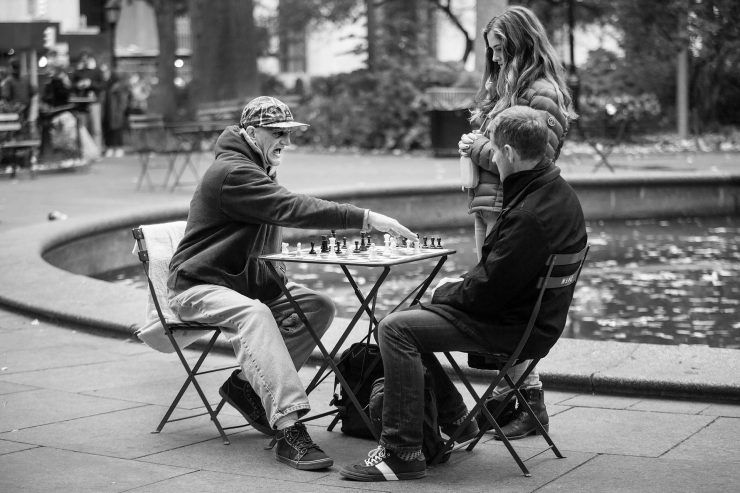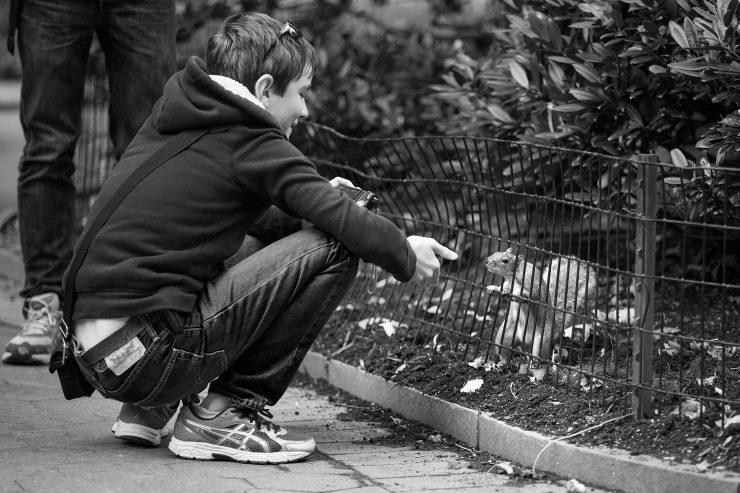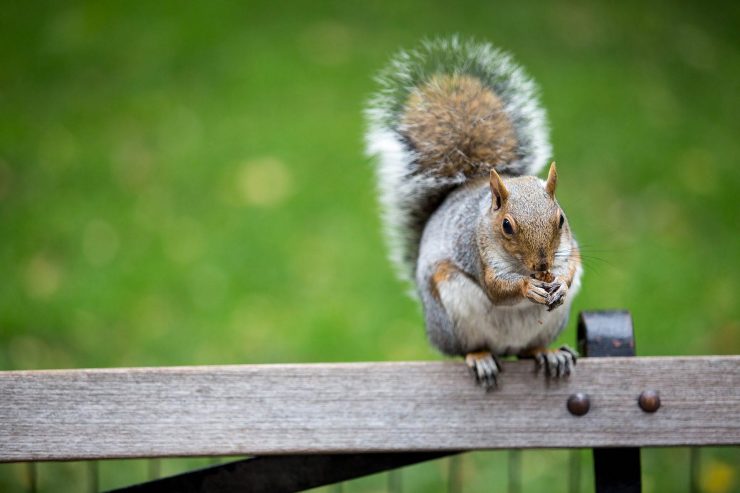Most of the photography I’ve done over the past several years has been solo. I often prefer to work alone, without constraints or influences, able to spend as much or as little time on an area or idea as I want. It was a nice change, consequently, to spend a couple of days shooting in New York City with Alfred Lopez, following our visit to the PDN PhotoPlus Expo this year. He has already published his thoughts on the experience at his blog, Fauxtojournalist.com, and it is very worth reading, but we also decided that it would be interesting, fun, and perhaps even helpful for us to get together and discuss our approaches and results, here. We hope that you agree that it is at least one of those things. – JMG
Matthew: I think of myself as a photojournalist rather than a street photographer, and my background and training is primarily in journalism. That, probably more than anything, influences the way I photograph people and events, and it also informs my choice of equipment. But I’m getting ahead of myself.
On Friday afternoon, Alfred and I left the Javits Center and the Expo behind, and decided to enjoy the beautiful autumn afternoon in Central Park. It was warm enough that I was comfortable in a hoodie, and the afternoon light was warm and yellow as it streamed between the skyscrapers and filtered through the trees. I think we had both had enough of obsessing over equipment, and I was inspired by Sam Abell (in particular) to go out and do some shooting of my own. We walked from the Javits through Times Square and up to the park, keeping our eyes out along the way.
It became clear pretty quickly that I am not up to speed as a street photographer. While Alfred was snapping away at interesting interactions between people on the street and capturing some intriguing moments, my camera mostly stayed at my side while I looked for design elements and interesting cityscapes. I made a conscious effort to start looking at the people around me instead, but with very limited success.

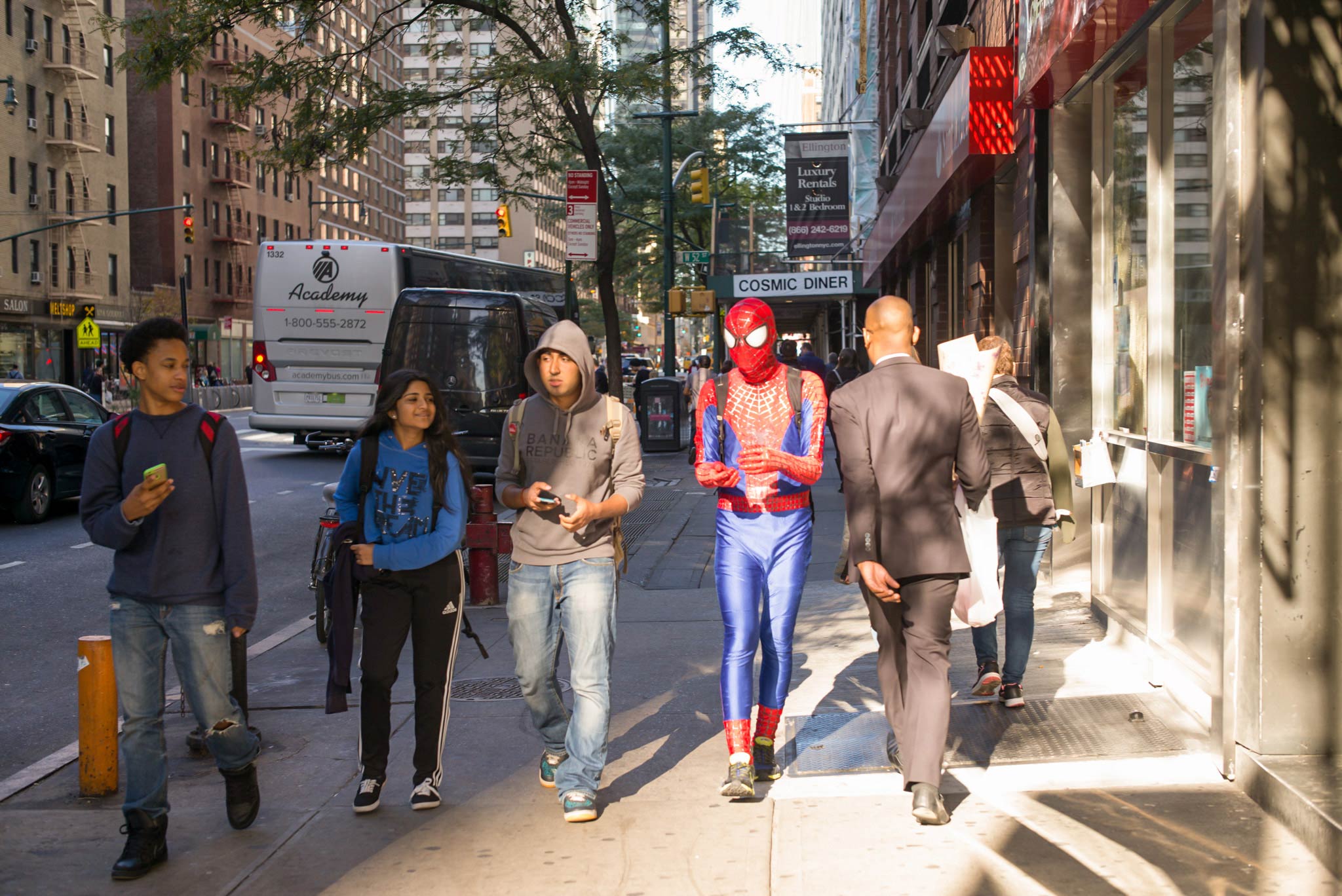
Alfred: Though Matt and I have gone shooting together one time before, it was in his own back yard in Seattle, so I was at a disadvantage. New York kind of leveled the playing field, even though we weren’t competing. I confess that I was a bit intimidated by Matt, being a photojournalist and all, so I started out a bit more cautious, then I remembered that this was an exploration for a bit of inspiration, so I was able to relax a bit. New York can be overwhelming.
The photo of the costumed teenager turned out to be more than what I had anticipated. I took a few frames as we were walking towards Spidey and his friends, but I was waiting for some gesture from him. I knew that the mask would hide any expression he may have had so it was a challenge to recognize a gesture that was descriptive enough to tell a story. The moment I saw the interaction of his friends with him and the position of his hands, I took this shot. I was shooting with a manual 50mm lens so I had my aperture set at f4 and smaller, at times, to account for missed focus. Shooting with a 35mm would have made zone focusing a lot easier, but I managed, nonetheless. When I finally looked at the photo on my computer monitor, it revealed not only the interaction that I was looking for, but the interaction with the environment. This is typical New York City behavior exemplified here: the man in the suit carrying, what seems to be, a bouquet of flowers (or a bag of churros), focused on his destination, not phased by Spider-Man, but fully aware of him due to the fact that he skirts around him within inches. And the pièce de résistance is the “Cosmic Diner” above Spidey’s head. I usually shoot/process in B&W, but this image, I decided that it should be in color. It doesn’t work any other way. Spidey is the fulcrum here and though he captures most of your attention, he balances the image nicely.
A lot of things escape my periphery when I’m shooting, but I wind up with shots like this one all the time, which begs the question “Do I actually see it subconsciously?”
Matthew: Once we got to the park, I was a little more in my element. There were specific areas where I could focus my attention, and the light was beautiful. I didn’t end up capturing anything that I loved, but at least I found some subjects.
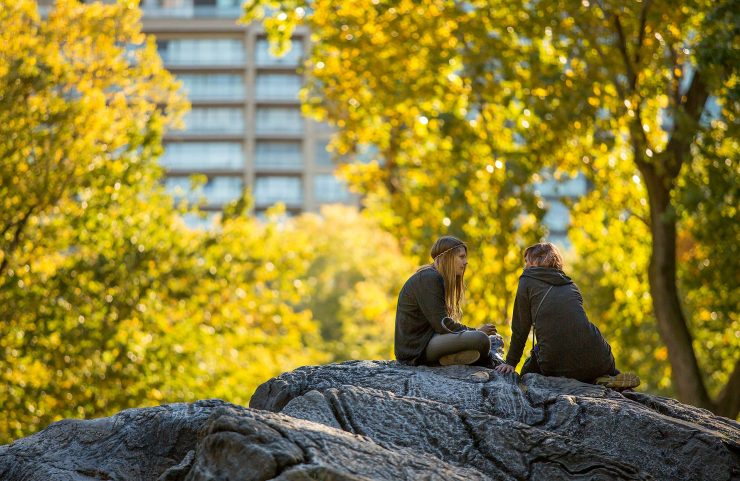
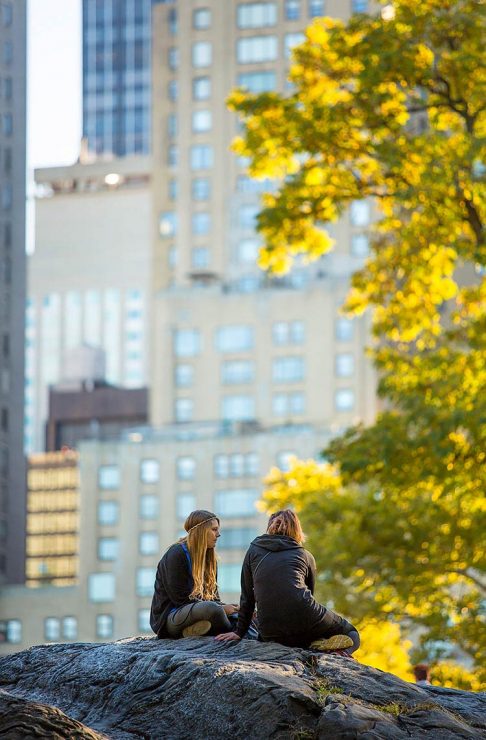
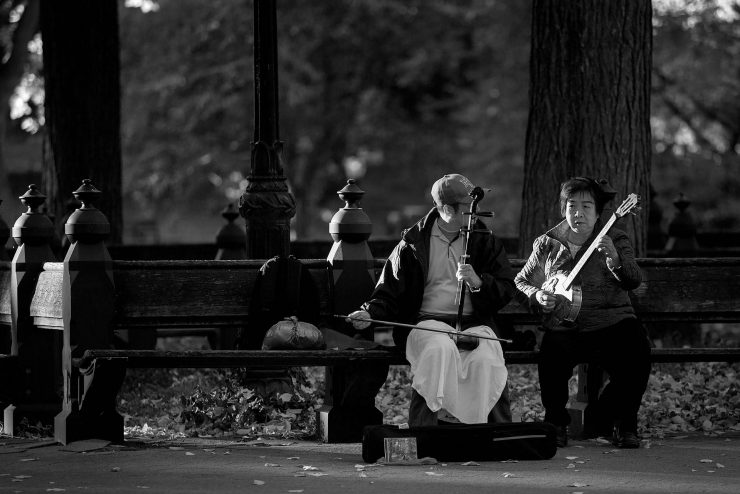
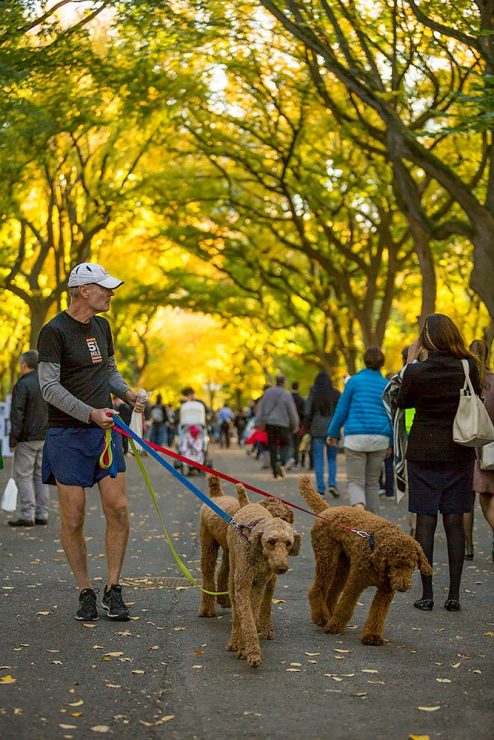
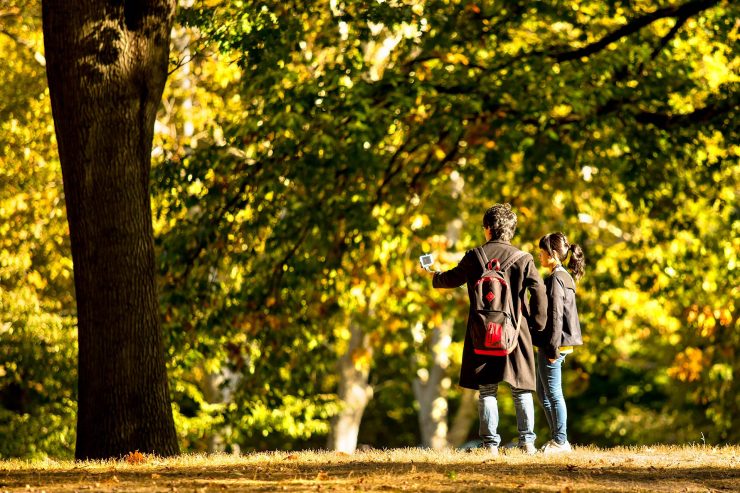
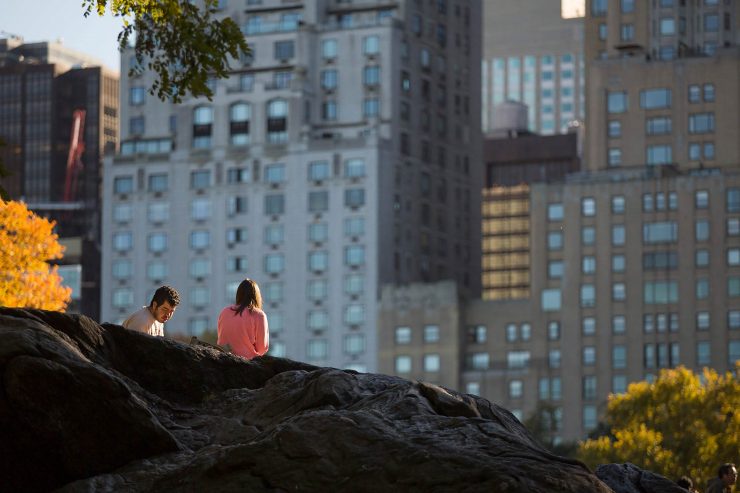
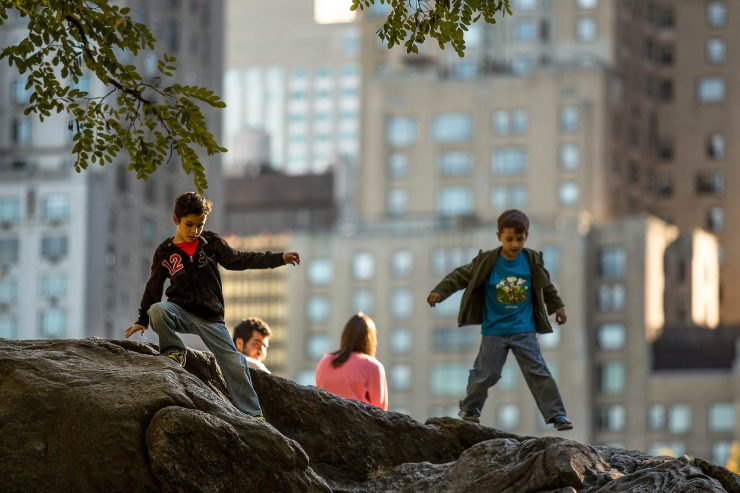
Leaving the park, I was actually a little frustrated. Any time I’m in a beautiful, interesting place, I feel like I should come away with some equally striking photos, but I knew that I didn’t this time.
Alfred: Central Park offered a lot more, in terms of autumn colors, but not necessarily anything else. Last time I was in Central Park, I was inspired to shoot, but I had two dogs with over-stimulation anxieties and didn’t get to shoot much, so I was excited to be there again. There wasn’t a lot going on, except a few weddings and many canoes in the water by Bow Bridge. I managed to intrude on one wedding on the bridge. Where the bride was standing, the park behind her offered a nice backdrop, so I took several shots. Passersby lingered on the bridge near the bride, thus ruining the full effect, but I think the shots are nice enough for a keepsake. I’m hoping that her photographer got good shots too. I felt he was taking too long prepping the bride.
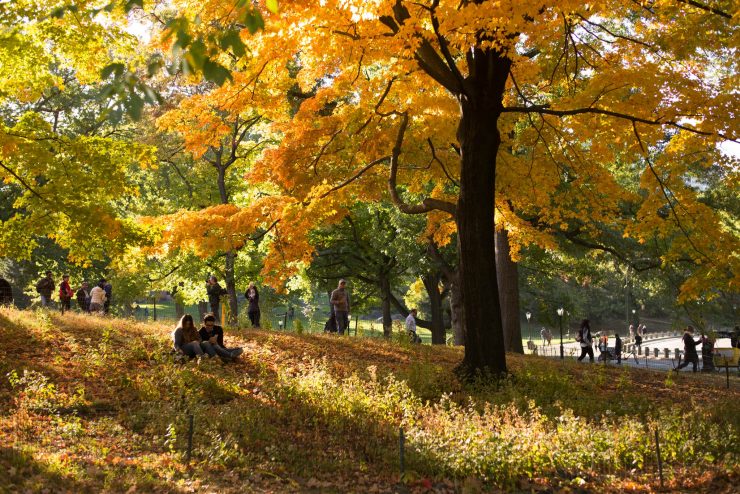
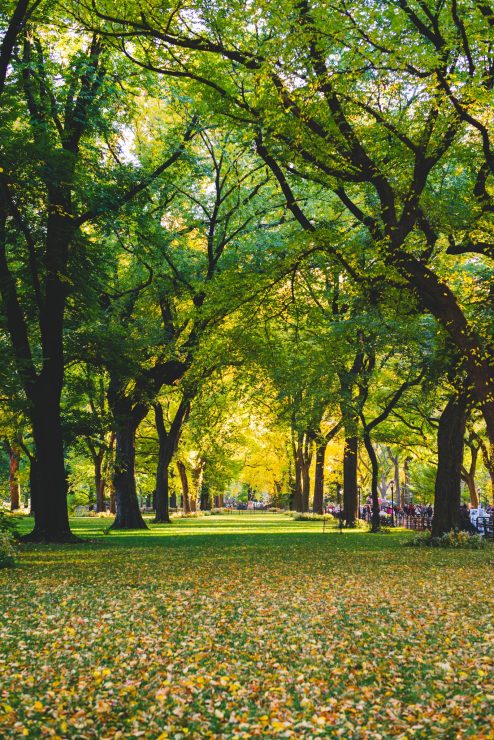
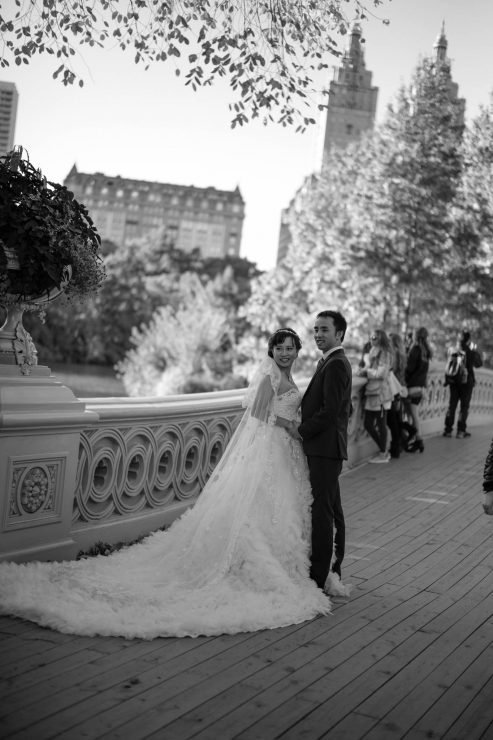
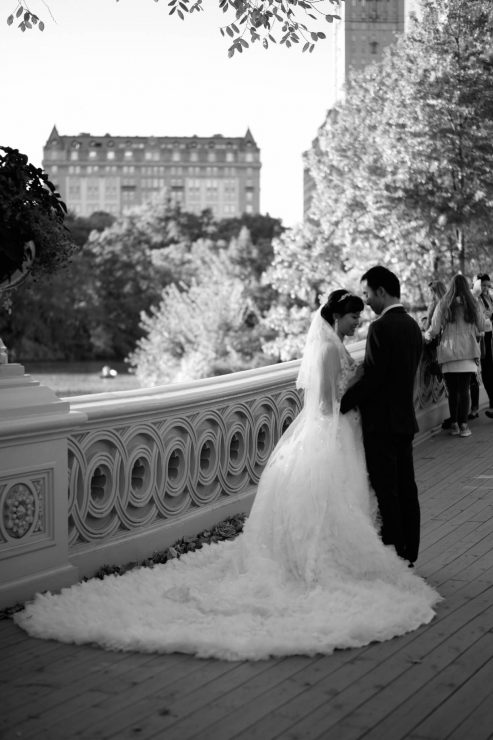
I don’t usually do landscapes (I’m mostly a wedding and portrait photographer), but lately I’ve been obsessed with trees. Overall, I’m satisfied with theses photos, though, like Matt, I was disappointed that I didn’t come out with some really nice photos that shows some genuine and “unique” interaction.
Matthew: Late the next morning, after meeting in the city and a quick brunch at Dunkin’ Donuts, we decided to wander downtown instead. It was chilly and overcast, so it was much easier for me to focus on the people around me rather than the light and shapes of the city.
As we wandered across town, we cut through Madison Square Park and I spotted some chess players. The older man playing was very animated and had an interesting face, so I worked the scene for a few minutes… finding the best light and different angles and waiting for action and expressions.
The first of these three images was the most successful at catching the action and expression of the older player. The shallow depth of field concentrates the focus on his face, his glance towards the woman includes her in the image, and his gesture pointing towards the younger man includes him. All of which is great, but it almost fails to say anything about what they’re doing: playing chess. The pieces just barely visible in the center of the image. I’d have preferred to get more of the board, but my (minimal) patience wasn’t rewarded, and I moved on to other angles.
The second image was an effort to incorporate something that Sam Abell had spoken about the previous day: micro-framing. While “framing” refers to how the entire image is composed in the camera (or later cropped), “micro-framing” refers to how specific elements are framed within the picture. Here, I tried to frame the couple cuddling in the background between the chess players, and also frame the reflections of the players in the pool at the bottom. I was happier with the results at the top of the frame than the bottom…. there’s too much dead space between the reflection and the players for the image to be very cohesive, but I still sorta like it.
The third image was actually one of the first that I took, and it’s the most straight-forward. It gives us all of the players, it gives us their location, it gives us some action, but I don’t think it does it in a very interesting way… the perspective is pretty ordinary, and the background is a little busy and doesn’t add much to the image.
In any case, street gaming became a nice theme for the day, and I ended up steering our walk towards Columbus Park in Chinatown to find more. On our way out of the park, I spotted an inline-skater with some nicely striped leggings and liked the pattern.

Matthew: The squirrels in the park were also pretty brazen. They had no qualms about running up and begging for food. I suspect they’d have run off with anything that wasn’t tied down, too.
Alfred: Madison Square Park had a lot of potential which I didn’t take advantage of. There was a playground that provided a lot of family interactions, but in this day and age, I feel society has a disdain for photographers peering into their lives, especially where children are involved. A few decades ago, it didn’t matter much. This is one of the points Matt and I discussed over gyros a bit later. Still, I managed to get a few shots from here. I was particularly drawn to the large tree at the entrance we walk through.
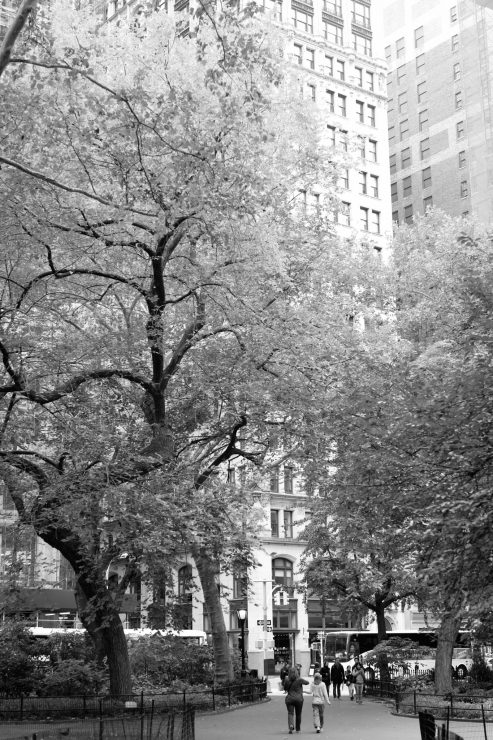
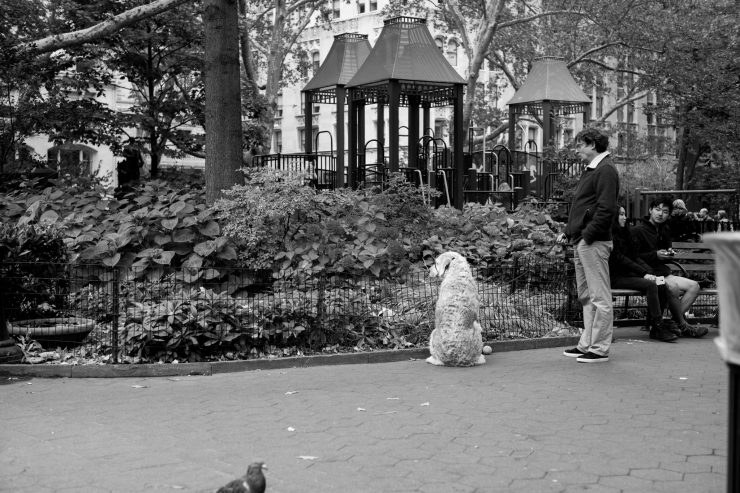
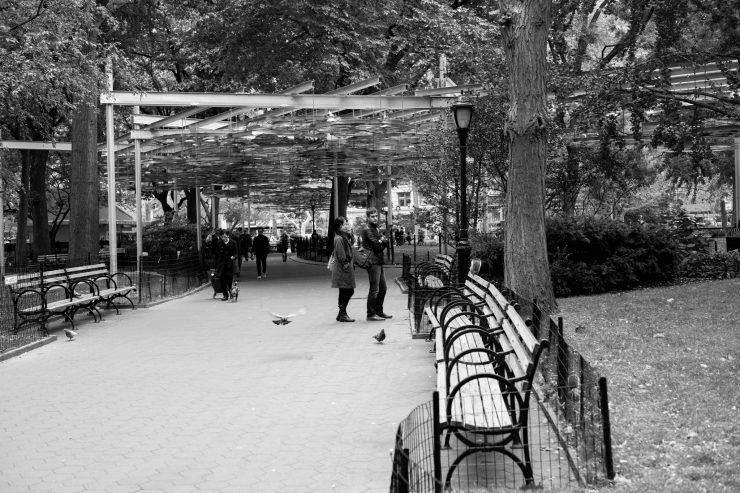
With every shot I take, I need to tell a story or give the image a sense of life or motion. So I waited for the mother and daughter, who had just passed by me, to enter the frame. To me, this gives a better sense of how grandiose the tree is. After which, I noticed a labrador and his owner looking at something in the bushes in front of them. It turned out to be a squirrel. After the critter was out of sight, the dog simply and nonchalantly pick up his ball and walked away. Though I enjoyed watching this, I wasn’t able to capture the essence of it in still frames. Sometimes what you see is not meant to be photographed or loses its meaning when photographed. This leads me to the third photo. I included it here to further demonstrate that point. I thought I would capture some symmetry amongst the subject in the frame: lady with the dog, the dog, the pigeon in mid-flight, the couple watching the squirrel eating a nut. In this case, getting closer is very important, therefore a tele or tele zoom would have worked nicely. I didn’t crop because of my sense of space. I like to place my subjects in a space, but in this case, it didn’t work out.
The sense of space also deterred me from taking a shot of the inline skater on the bench. I worked the scene in my mind and it didn’t bode well, but Matt was able to pull it off by his sense of detail, which, ironically, is something we talk about often.
Matthew: As long as we’re on this subject, I actually took a photo at almost the same instant, but with the telephoto. The shallow depth of field that results from shooting with the longer lens meant that I had to choose whether to have the squirrel in focus or the couple. I chose the squirrel, but since I caught it in mid-stride and missed it’s face, the picture doesn’t really work. It does show how the image is different with tighter framing, though. The frame was composed with the line of the benches leading the eye from the corner of the frame up to the center and the subjects.
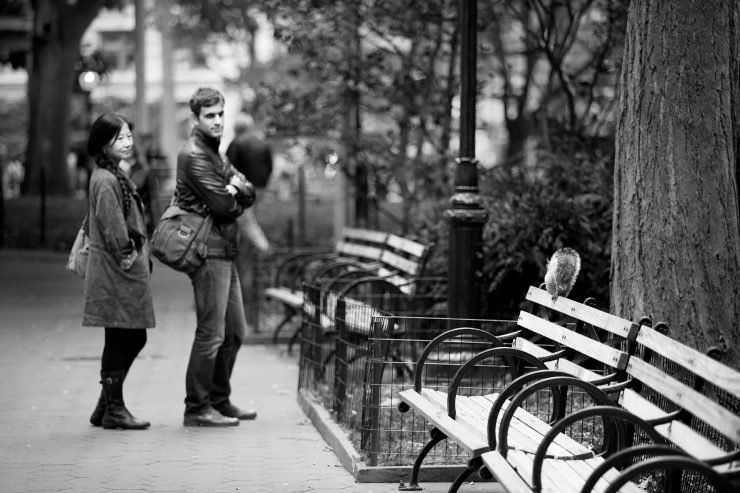
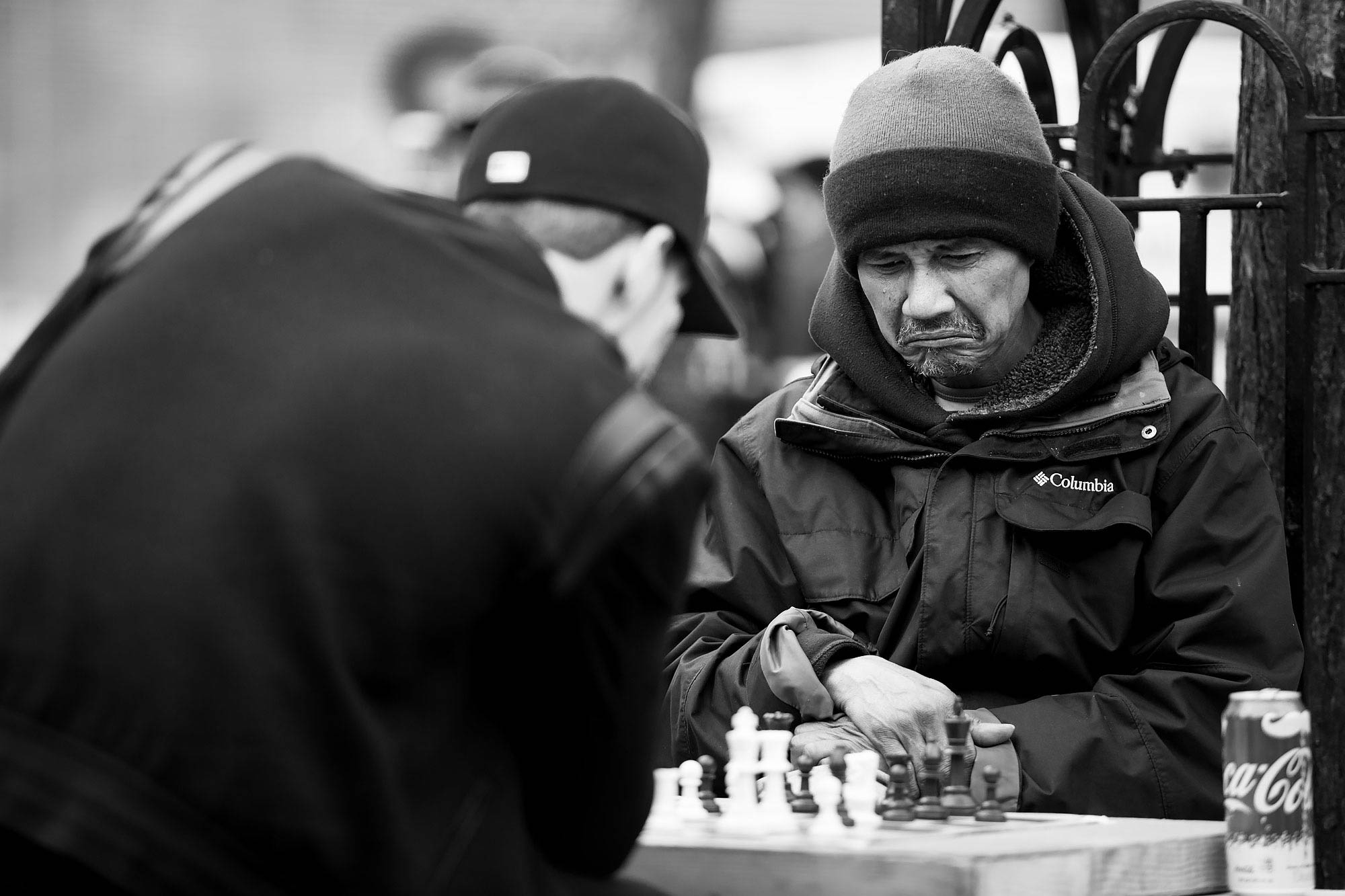
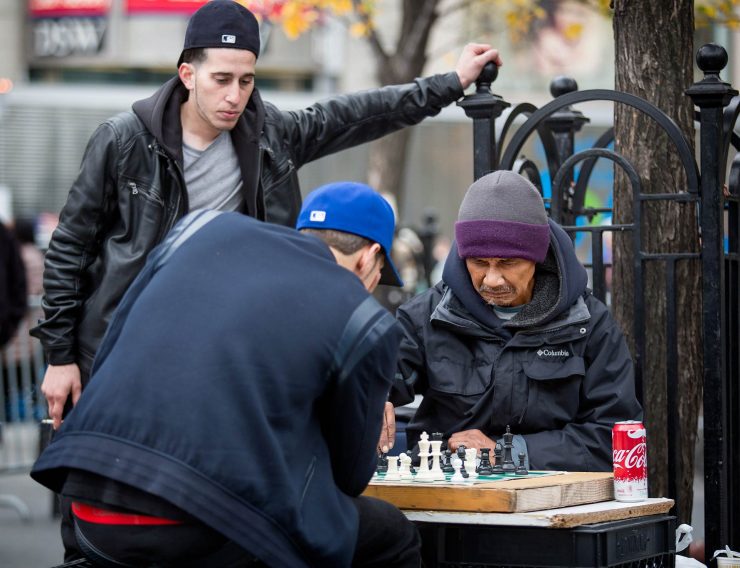
Alfred: Matt and I targetted the same set of chess players. We were both looking for expressions. But where Matt stood away to composed his shot, I stood to Matt’s camera right, about five feet from the players. I took several frames trying to capture the players’ expression, but I settled on the very first frame.
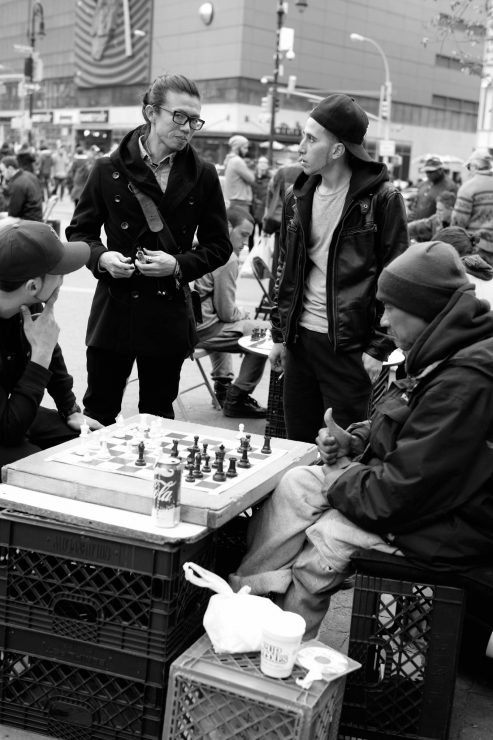
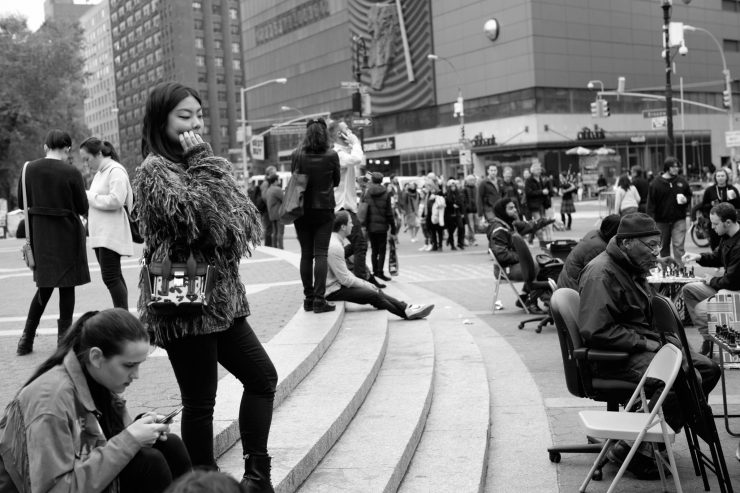
The spectator’s glance (guy with glasses) at me is fitting: looking at how he’s dressed, it’s apparent that he’s the leader amongst the hustler’s opponent (seated guy on the left) and the guy to his left, but his expression cements that appearance. Also, the fact that the other two are looking up to him adds to the story. Though I prefer this shot, Matt’s version of the scene is just as effective: it gives pause to know what’s going through the hustler’s mind. We didn’t stay long enough to find out who the victor was. In my second shot, I used the standing girl on the left as part of a frame, but waiting a bit for her to turn her face towards me to complete the scene. Her expression seems to be the result of her conversation with the seated girl next to her. To me, this photo reminds me of a mirror image of Georges Seurat’s “A Sunday Afternoon”. Though my picture is gray, they’re both created with dots. <smile>
Matthew: Along the way, I looked down a side-street and saw this nicely symmetrical composition, and I wanted to try out another of the techniques that Sam Abell mentioned: finding an interesting composition, and then waiting for the action to occur in it. Abell’s upper-limit for waiting is 20 minutes.
I wasn’t willing to wait that long. In part, I didn’t think that the composition I’d found was all that great. I liked the symmetry, and I like how strong the signs are: STOP and ONE WAY. It would have been perfect, I thought, if I could capture a bicyclist passing through the frame from the wrong direction. Or a delivery truck. Or a dog, even. Ideally, that white SUV would have been driven away first.
But my patience didn’t last that long. Also, I was standing in the street, and I value my life. Instead, I waited until a pedestrian was micro-framed by the “Vintage Vintage Vintage” chalkboard, and moved on. As a result, it’s a pretty blah image, but it was instructive to try consciously try out the technique.
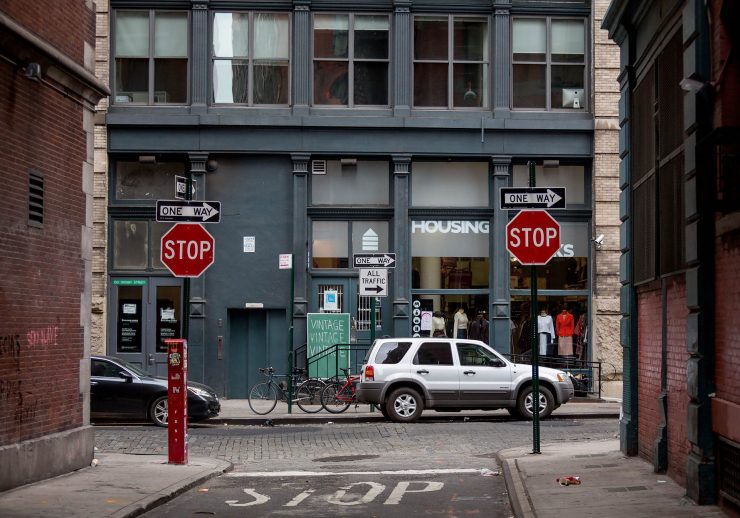
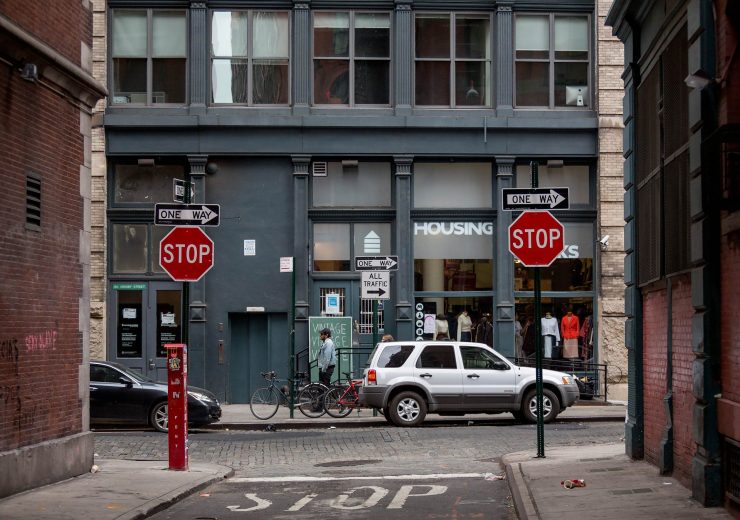
Alfred: I didn’t realize Matt took these shots. The second shot has a calmness and coziness to it.
Matthew: On the way down to Chinatown, there were a couple of other subjects that we both encountered and photographed in very different ways. One was a girl in a candy-corn witch costume. I might as well mention now that it was not Halloween. It was a full week before Halloween. I can only assume that there are pre-Halloween parties in New York, so as not to interfere with candy collection. That’s wise, actually.
Anyway, we noticed this girl and her family ahead of us. I thought that the costume was a nice contrast to the dull grey of the city, but I wanted to get her face, so after a couple of blocks, we managed to pass them (small children sometimes walk even slower than photographers), and as the little girl stopped to fuss over something or other, I took a couple of shots. I framed her as close to the bottom of the frame as I could to emphasize that she was a small girl in a big city, and to show off the color contrast with the background. At the time, I liked the idea of compressing the city backdrop and the girls with the telephoto, but now I think that bringing in more of the background with a wide angle lens might have worked just as well, as long as the depth of field could be sufficiently shallow to keep the focus where it should be. Being close enough to use a 35mm lens, though, probably would have distracted the girl, and worse, worried the mother.
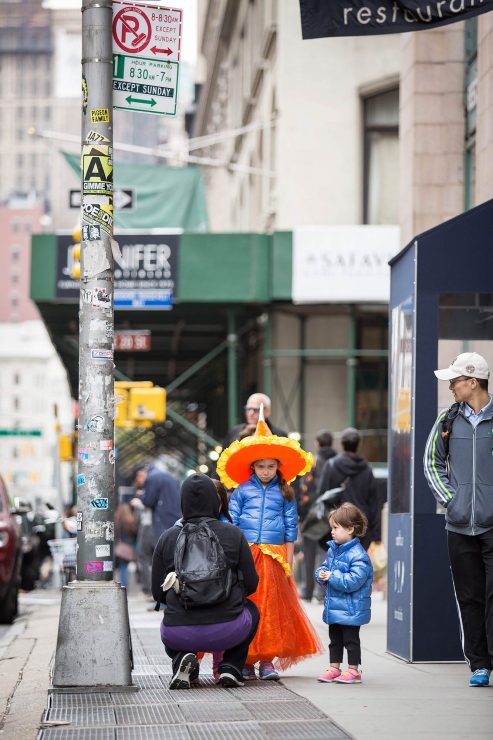
Alfred: Matt captured a scene with “candy corn girl” (CCG) that I would have liked. I especially like CCG’s sister’s worried expression.
Matthew: Similarly (perhaps it was as we were leaving Chinatown, actually), there was a girl in a bright purple princess/fairy costume on the corner with her father. I basically wanted the same type of picture; child low in the frame, city emphasized behind, and some kind of action or expression.
My first shots didn’t work very well. I couldn’t get a clean composition… the crowd on the corner made it a very busy frame, and the costume wasn’t bright enough to dominate all of that, and the expression that I managed to capture looked more bored and distracted than anything else.
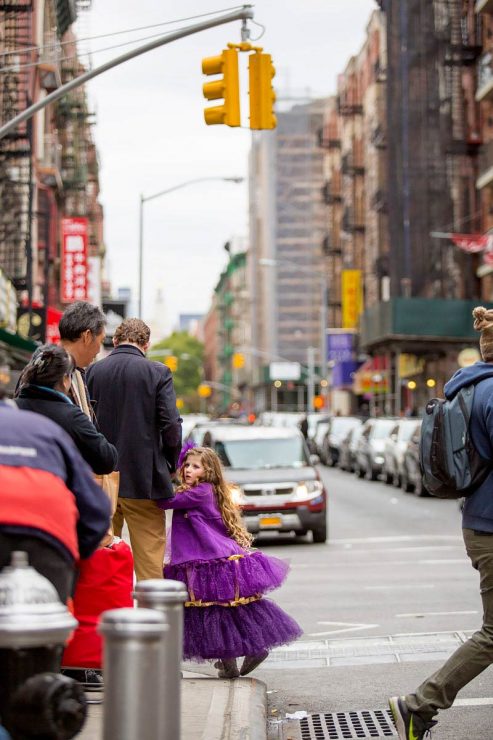
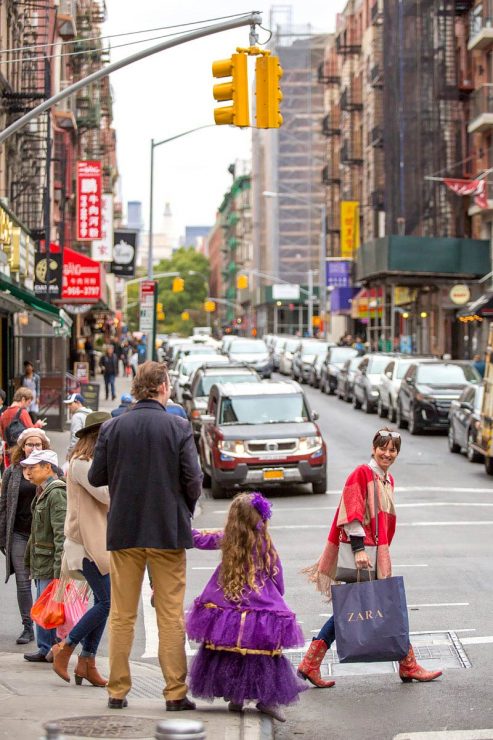
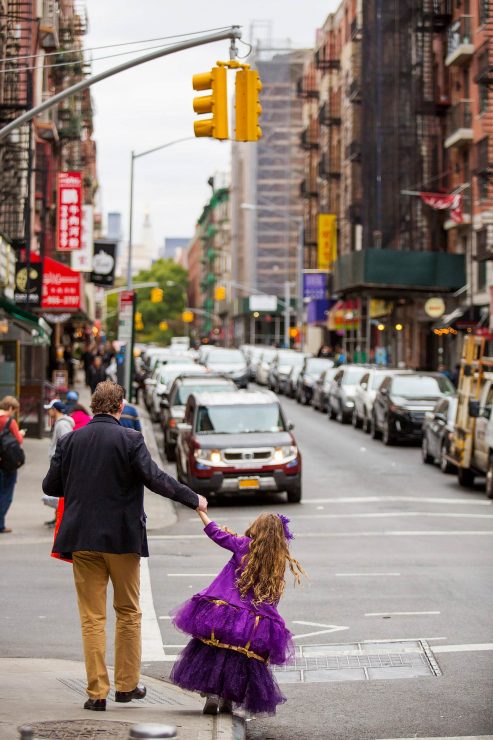
The second photo caught a bit of interaction between the girl and a passer by, but it still didn’t say much about the girl herself. The third photo is hardly perfect, but to me, it seemed like a much cleaner composition, as they started leaving the curb. The man is taking a step, bringing in a bit of motion to the image, and the girl is leaning playfully to the side. That says more to me than the expression in the first shot. I’m not really proud of any of them, ultimately.
Alfred: We noticed purple dress girl from the opposite corner of the street. I noticed her “playing” with her father while he paid attention to his smartphone. I wanted to capture that playfulness, so I stood a few feet away from them waiting for her to peek around her father.
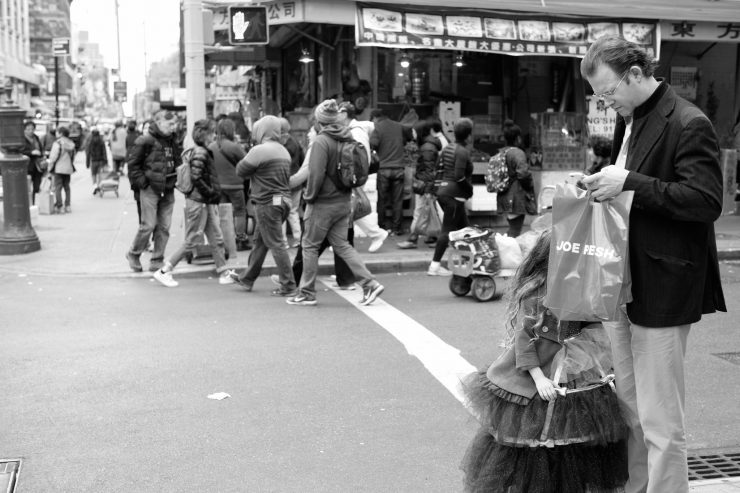
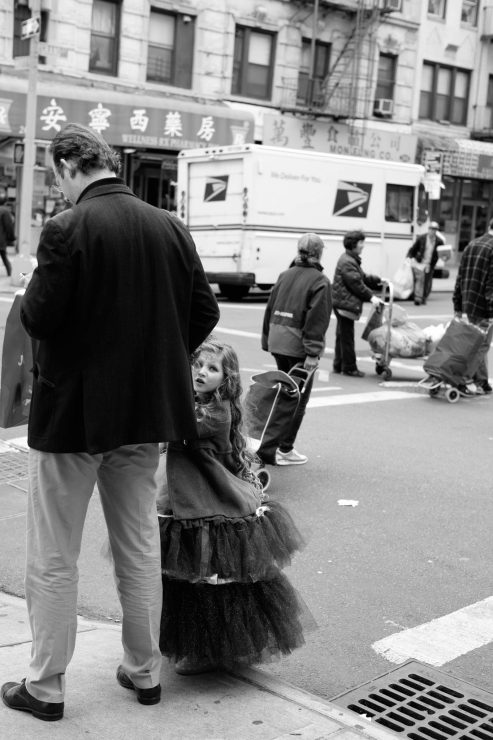
I waited 1/10th of Abell’s limit only because of my lack of patience and I really didn’t want to push my luck. I walked behind the father (who still hadn’t noticed me) and waited a few seconds and the little girl peeked behind him. But what I caught was a bit ghostly. Not what I expected, and I think my composition could have been better. I do, however, like Matt’s last shot showing the girl’s playful side.
Matthew: At Columbus Park in Chinatown, the tables were filled with gamblers. Perhaps there was no money involved with some of the games, but in the pavilion games I saw quite a few bills change hands.
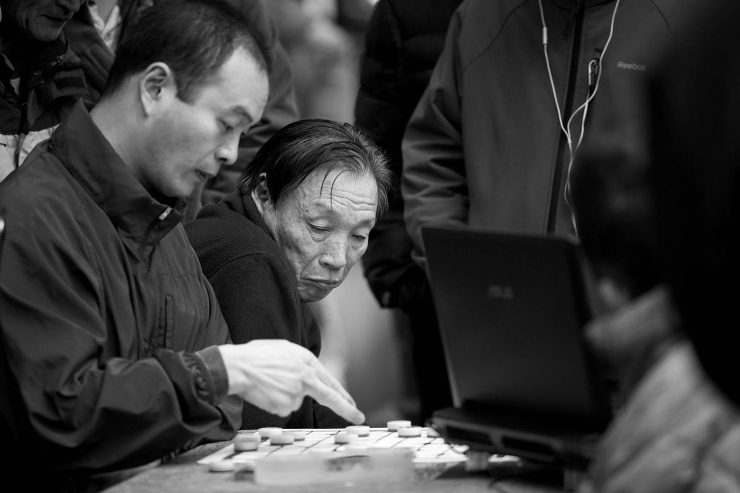
After we’d been there for a few minutes, I had to change things up. Up to that point, I’d been shooting with my 70-200 f/2.8 all day. Then two things happened. In that setting, the big white lens was drawing a lot of attention, so I decided to switch over to the 50mm f/1.4. I also had a battery problem. One of the batteries in my grip suddenly died, and instead of switching to the other battery, the camera died. So, I removed the grip and used the good battery. Consequently, I was shooting with a much more discrete setup (if a full sized DSLR can ever be considered discrete).
But the focal length wasn’t great. It wasn’t wide enough to be useful around the tight, crowded tables, but it couldn’t give me the distance to stand back be not be noticed at all.
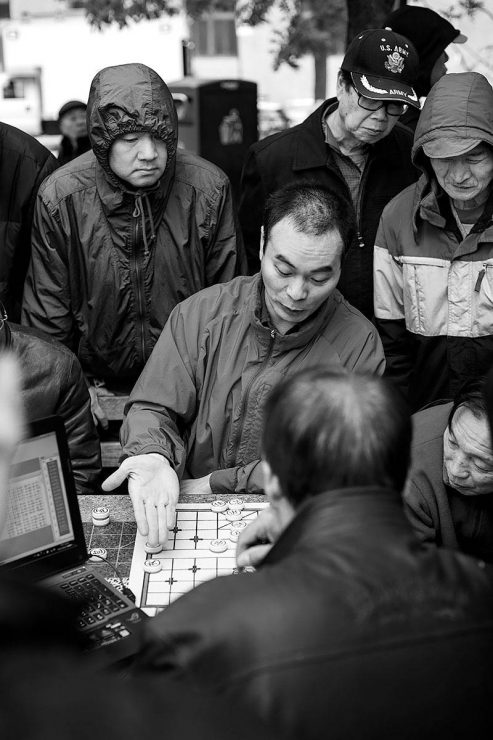
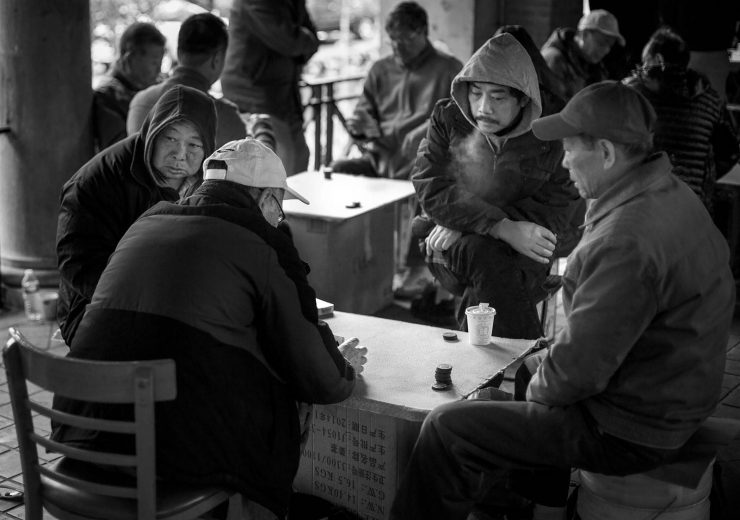
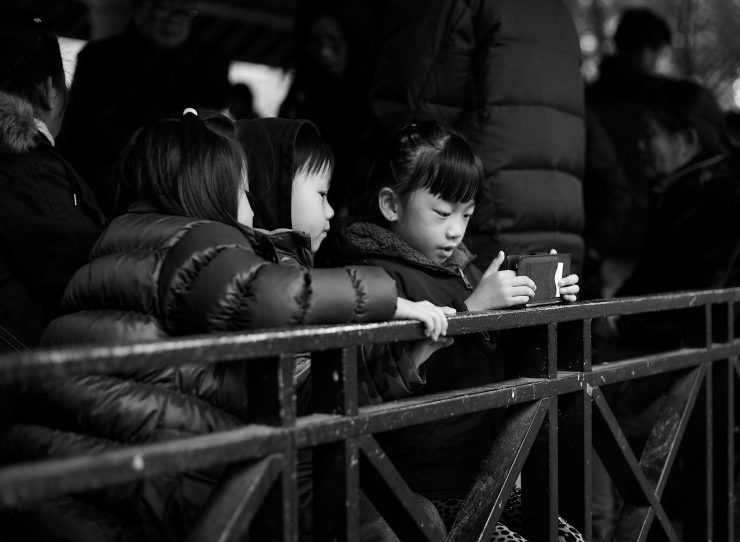
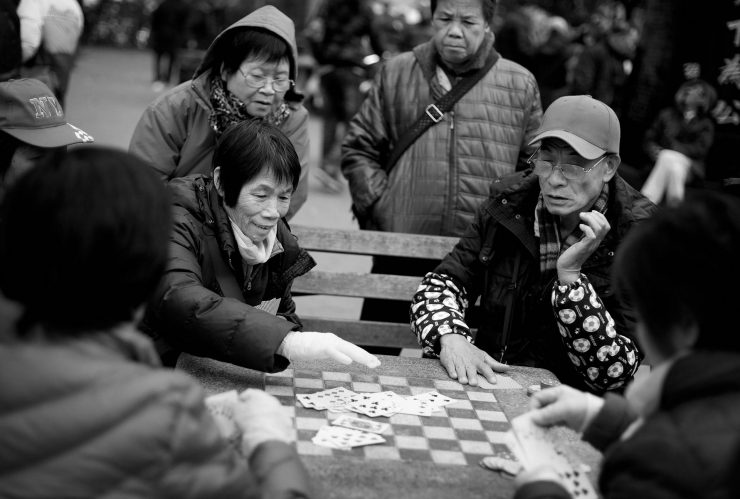
Alfred: We spent quite a while at Columbus Park. I decided to create portraits so my shooting was more calculated. I didn’t understand the games being played, but the players were quite animated. Though I was carrying the Fuji X-E2 and the 18mm f2, I decided not to enter the gamblers’ den, which may have been a mistake. I did, however, capture another view of Matt’s “Behind the Gambler’s Den”, though not as impactful. After Columbus Park, we went for a spot of tea and concluded the day.
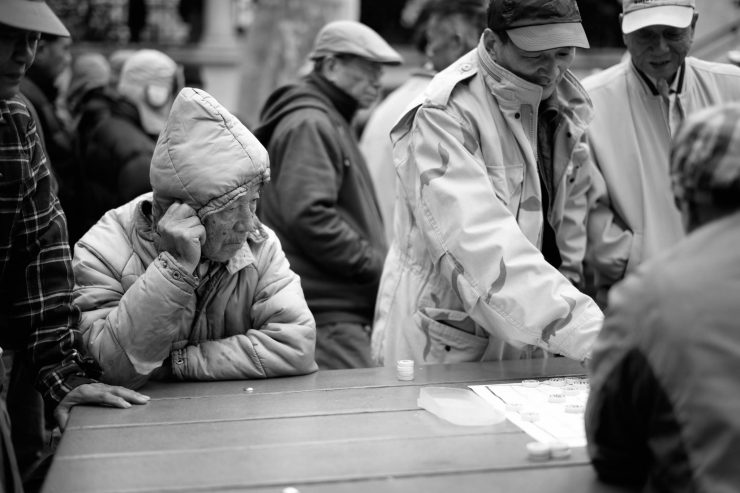
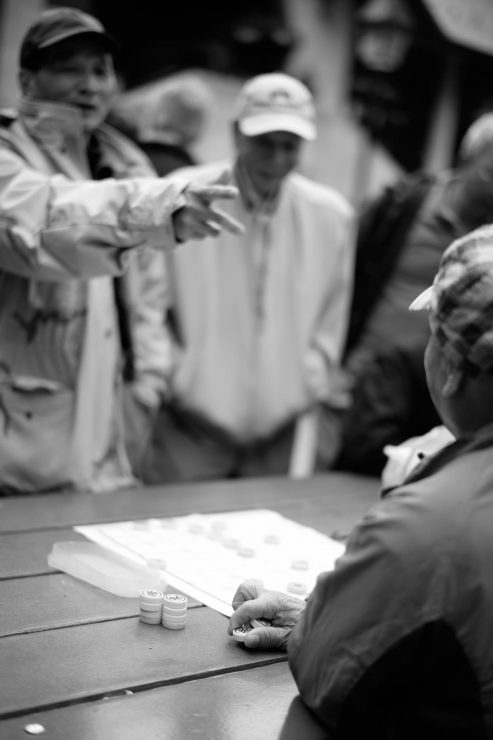
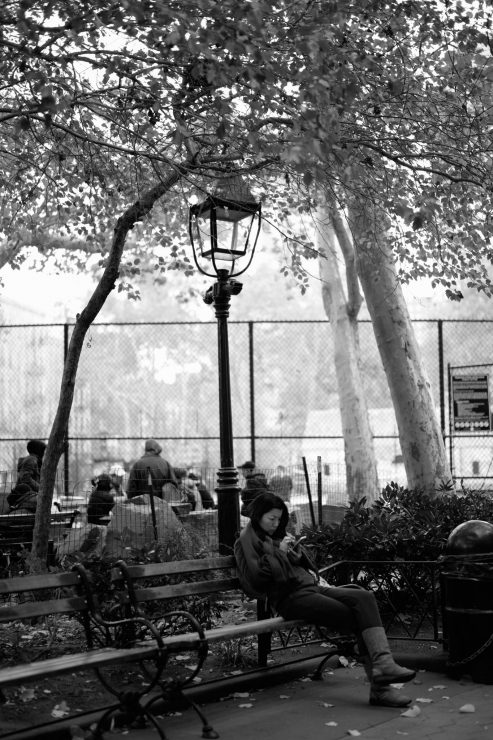
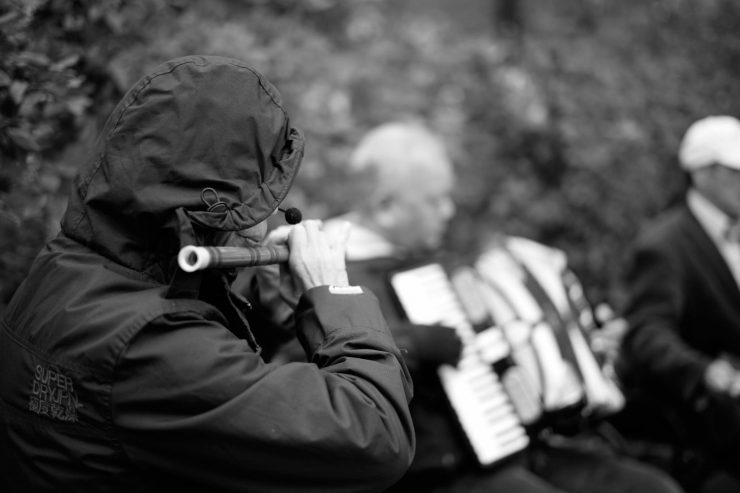
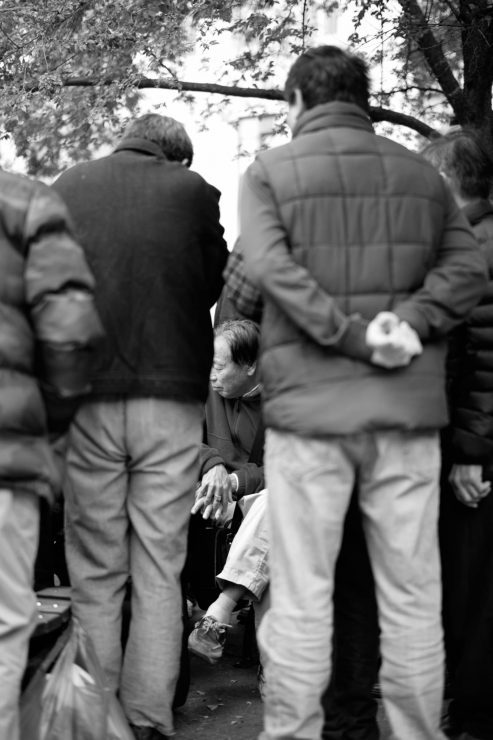
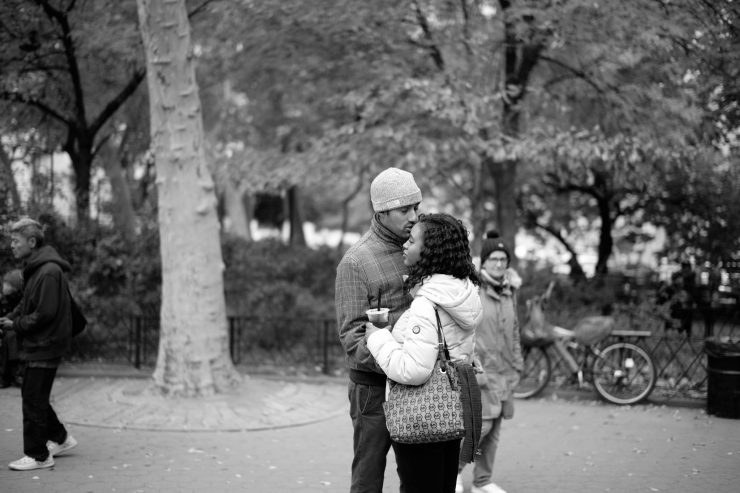
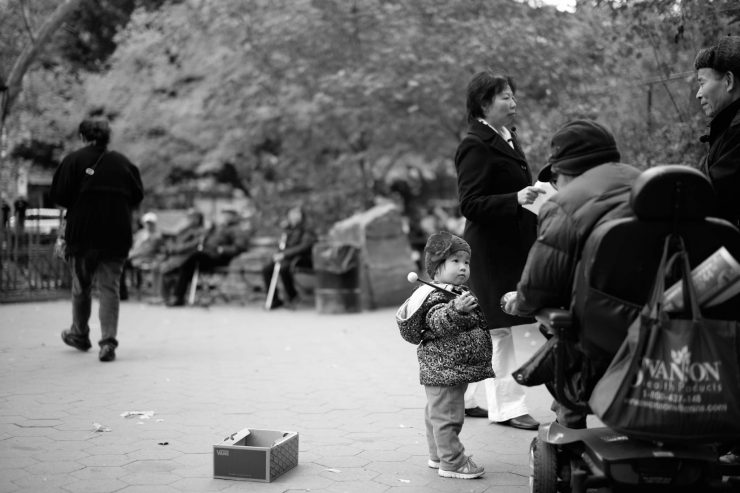
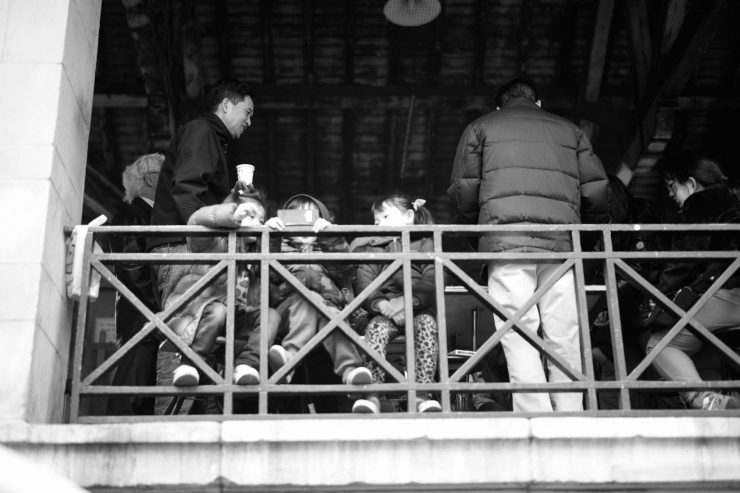
I think next time I will focus on making my images I bit more consistent, though I’m quite happy with the ones I came away with this time.
Matthew: If I had to sum up the differences in our approaches to composition that we see with these images, I think that Alfred prefers a looser composition with an emphasis on capturing a place’s ‘feeling’, and setting his subjects within a place, whereas my intent is to create a simple, easy-to-read composition that removes elements that don’t contribute to the particular message or story that I’m trying to tell.
Here are a few more images that didn’t find a place in the story above. Some of them probably don’t deserve to be here at all, but they tickled my fancy for one reason or another :
